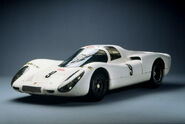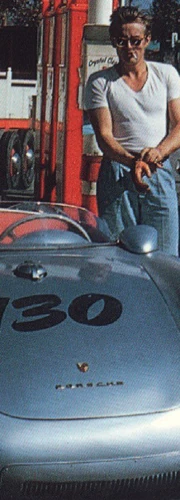
| |
| Porsche 907 | |
|---|---|
| Porsche | |
| aka | Porsche 907 |
| Production | produced in 1967, based on Porsche 910 |
| Class | Sports Car [FIA Sports Prototype, Group 6] |
| Body Style | Coupe (Short tail and Long tail) |
| Length | 4033 mm ( 158.8 in ) (Short tail) 4839 mm ( 190.5 in ) (Long tail) |
| Width | 1720 mm ( 67.7 in ) |
| Height | 940 mm ( 37.0 in ) |
| Wheelbase | 2300 mm ( 90.6 in ) |
| Weight | 600 kg ( 1322 lb ) |
| Transmission | 5 speed synchronized (Porsche 901), Rear wheel drive, longitudinal mid-engine |
| Engine | (1) 2.0 liter six-cylinder horizontally opposed (Porsche 901) (2) 2.2 liter eight-cylinder horizontally opposed air-cooled (Porsche 771) |
| Power | (1) 220 HP (164 kW) @ 8000 RPM (2) 270 HP (201 kW) @ 8600 RPM |
| Similar | Dino 206 GT Chevron B4 Alfa Romeo 33 |
| Designer | Porsche Experimental Department Under the leadership of Ferdinand Piëch and Helmut Bott |
The Porsche 907 was a sportscar racing prototype built by Porsche in 1967 and 1968.
1967[]
The 907 was introduced at the 1967 24 Hours of Le Mans. As suggested by Ferdinand Piëch, the position of the driver was moved from the traditional left (as in German road cars) to the right as this gives advantages on the predominant clockwise race tracks.
With a new longtail body, the 907s reached 302 km/h (190 mph) on the straight even though they used the reliable 220 hp Porsche 910 2000cc 6-cyl rather than the more powerful 8-cyl. Also, vented brake disks were used as standard from now. The best Porsche 907 finished 5th, beaten only by Ford and Ferrari with their much bigger engines.
As the record-breaking performances of the 7.0L V8-powered Ford had triggered rumors about a future rule change, Porsche started to prepare themselves in summer of 1967. The 907 was equipped with the 270 hp 2200cc 8-cyl which was then modified for the rules of the new 3 litre prototype category that was announced in late 1967 to come in effect already in 1968. An engine with the full 3000cc would have to be developed first, though, to be introduced in the future Porsche 908.
1968[]
From 1968, the big V8 and V12 prototypes of Ford and Ferrari were banned, and Porsche hoped to secure the World Sportscar Championship and maybe an overall win at Le Mans as the competition at Ford, Matra and Alfa Romeo was not prepared with suitable 3000cc prototypes yet, either. Ferrari even sat out the whole of 1968 as a protest against the rule change. Apart from the former 2000cc-class rivals Alfa Romeo T33/2 and Renault-powered Alpine, 5000cc sportscars were also permitted to enter if at least 50 of them had been built. This loophole was intended to fill the grid with cars dating mainly from 1965, like Ford GT40 and Lola T70.
Porsche was serious. Unlike during the rather modest earlier years, four cars were entered in the 1968 24 Hours of Daytona, supported by 20 mechanics and engineers. The drivers wore cooling vests developed by NASA as the oil-cooler and the hot oil pipes caused heat in the closed cockpit.
After the #53 car of Gerhard Mitter had a big crash caused by tyre failure in the banking, his teammate Rolf Stommelensupported the #54 driven by Vic Elford/Jochen Neerpasch. When the #52 car of the longtime leaders Jo Siffert/Hans Herrmanndropped to second due to a technical problem, these two also drove on the #54 car in case theirs broke down. Due to this, five pilots won the race, and two of them scored also second. The #51 Jo Schlesser/Joe Buzzetta car completed the 1-2-3 side-by-side parade finish that the Ferrari prototypes had shown a year earlier at the banked finish line. The three Alfa Romeo T33/2's were even beaten by a Ford Mustang.
The 1968 12 Hours of Sebring saw a 1-2 finish for the Porsche 907, with the Jo Siffert/Hans Herrmann car winning and the Vic Elford/Jochen Neerpasch car finishing 2nd. The Gerhard Mitter/Rolf Stommelen and Ludovico Scarfiotti/Joe Buzzetta cars were victims of engine failures. Daytona & Sebring marked the first back-to-back major outright wins for the company, and French journalist (and occasional racer) Bernard Cahier wrote, "it's hard to imagine that anyone could beat Porsche to the championship this year." Their championship hopes in Sportscars and F1 would be significantly changed soon, though.
The next race was the BOAC 500 at Brands Hatch, on April 7, 1968. That fateful day, Jim Clark was supposed to drive one of the new Ford F3L P68 prototypes with the Cosworth DFV engine, entered by Alan Mann Racing. Clark instead was driving a Formula 2 at Hockenheimring to show the new sponsorship logos for Team Lotus, and was killed. Jo Siffert/Hans Herrmannwere fastest in qualifying ahead of Bruce McLaren/Mike Spence in the new Ford, but none finished. It was the updated John Wyer-entered Ford GT40 of Jacky Ickx/Brian Redman which won ahead of the remaining two Porsche 907's after being only 5th on the grid.
In races on faster tracks like the 1000km Monza, these modified old Ford GT40's entered by JWA Gulf Racing Team proved to be an unexpectedly strong force. The loophole for these 5-liter sportscars was opened if at least 50 were built, to let the many existing Lola T70's take part, too. For 1969, the minimum number was lowered to 25, which opened opportunities unexpected by many.
At the twisty Targa Florio, the only privately entered GT40 finished last, but the Alfa Romeo T33/2 were strong. In lap 1, Vic Elford had lost 18 minutes due to a tyre failure. Supported by veteran Umberto Maglioli, he showed a fantastic race in the 907, reminiscent of Juan Manuel Fangio's legendary 1957 German Grand Prix, beating the old lap record by one minute and winning by 3 minutes. Hans Herrmann & Jochen Neerpasch came in 4th among four Alfas. In the Porsche advertising poster celebrating the win, only an exhausted yet smiling Elford was shown, not the cars as usual.
The 1000km Nürburgring was won with the new Porsche 908 with its 3000cc engine, but it still was unreliable. The underpowered 2200cc 907 with less than half the Ford's displacement continued as Porsche's best entry in the 1000km Spa, Watkins Glen 6 Hours and 500km Zeltweg, losing to the Ford GT40's.
This set up the stage for a showdown at la Sarthe, as due to political unrest in France, the 1968 24 Hours of Le Mans had been postponed from its traditional mid-June date to the end of September. Porsche could not take advantage of the additional time to improve the 908 nor read the French rule book properly. For the first time, Porsche were the fastest in qualifying and the early stages of the race, but troubles with the 908's alternator caused delays and even disqualifications as the new Porsche staff had misinterpreted the repair rules.
For the third time in a row, a V8-powered Ford won the 24h classic. A Porsche 907LH came in second in front of the sole surviving 908. In addition, Ford had taken the World Sportscar Championship, too.
At that time, Porsche had already decided to make a risky investment in order to go one step further beyond the 3-liter 908 prototype: they committed themselves to develop a new 5-liter sportscar and built the required number of 25 in advance. This car was the legendary Porsche 917.
1969 - 1971[]
During the following seasons, several 907's were entered by privateers, scoring occasional top-10 finishes, with a podium at Monza in 1969 and a 7th at the 1971 24 Hours of Le Mans being the more remarkable results.

|
This page uses some content from Wikipedia. The original article was at Porsche 907. The list of authors can be seen in the page history. As with Autopedia, the text of Wikipedia is available under the GNU Free Documentation License. |
Gallery[]


